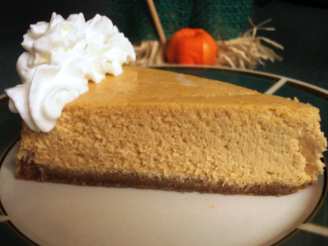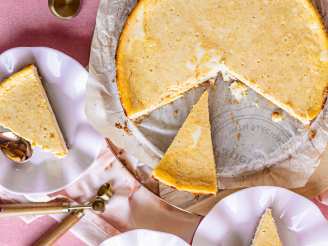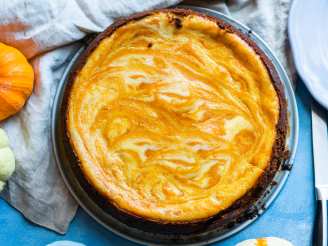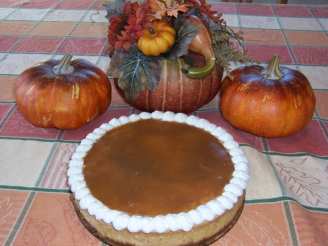Pumpkin Cheesecake (Including Water Bath Instructions)
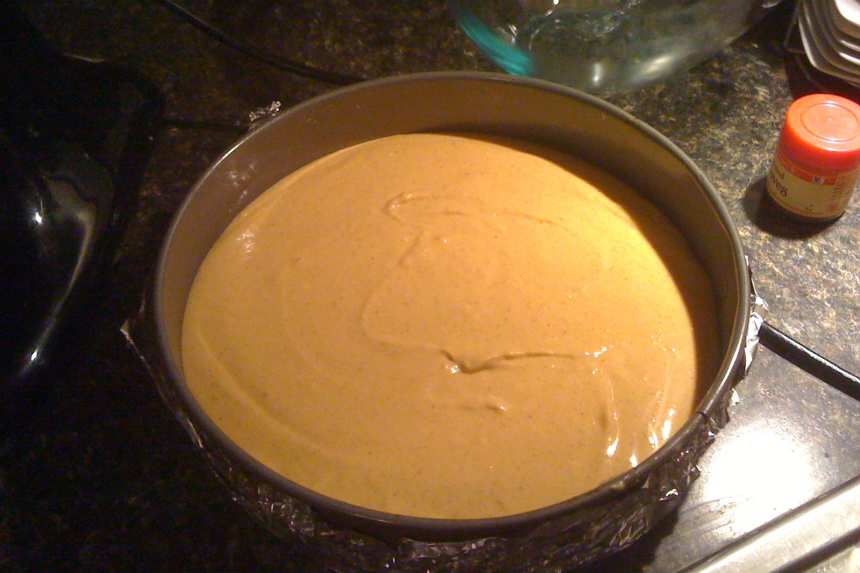
photo by Heather N.

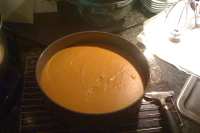
- Ready In:
- 1hr 30mins
- Ingredients:
- 11
- Yields:
-
1 cheesecake
- Serves:
- 6-8
ingredients
- 1 1⁄2 cups graham cracker crumbs
- 5 tablespoons butter, melted
- 1 tablespoon sugar
- 3 (8 ounce) packages cream cheese, softened (do NOT substitute reduced fat, or whipped cream cheese)
- 1 cup sugar
- 1 teaspoon vanilla
- 1 cup Libby's canned pumpkin (not pie mix)
- 3 eggs
- 1⁄2 teaspoon cinnamon
- 1⁄4 teaspoon nutmeg
- 1⁄4 teaspoon allspice
directions
- Preheat the oven to 350 degrees F.
- *************Crust************.
- Combine the graham cracker crumbs with 1 Tablespoon of sugar and then drizzle the melted butter over the top.
- Mix this together well enough to cover all of the crumbs with the butter. Do not let it turn into a paste.
- Press the crumbs onto the bottom and about two-thirds of the way up the sides of the springform pan. It’s ok if it doesn’t go all the way up the sides. You want part of the cheesecake to extend above the crust.
- Bake for 5 minutes, then chill it in a refrigerator for up to 24 hours.
- **************Filling*************.
- The cream cheese should be at room temperature before you begin mixing, or you'll end up with lumps in your cheesecake. Using cold cream cheese also leads to overbeating--whipping too much air into the batter--which forms unattractive air bubbles on the surface of the cake. Reduced fat and nonfat cream cheeses contain fillers that might prevent the cheesecake from setting properly. Never substitute whipped cream cheese for the solid block.
- Combine the softened cream cheese 1 C sugar, and vanilla in a large mixing bowl.
- Mix the cream cheese and sugar by itself until it's smooth and light, before adding any other ingredients. If you end up with lumps in your batter, run the mixture through a sieve or give it a quick spin in the food processor and you'll have silky smooth results. Mix until smooth using an electric mixer (remove the lumps but don’t over-mix). Be sure to mix your cheesecake batter well, eliminating all possible lumps in the cream cheese BEFORE you add the eggs. It is the eggs that will hold air in the batter, so add them last, and mix as little as possible once they are in the mix.
- Add the pumpkin, cinnamon, nutmeg and allspice and continue beating until smooth and creamy.
- Lightly beat room temp eggs and add to batter mixture, and blend well, do not over whip as adding eggs and over mixing can add air to the mixture which will want to escape while baking and create a crack.
- Pour the mixture into the graham cracker crust.
- Note: Cheesecake is a custard at heart. It's delicate, so you want to bake it slowly and evenly without browning the top. The most effective way to do this is to bake it in a water bath. Since water evaporates at the boiling point, the water bath will never get hotter than 212 degrees F (100 degrees C), no matter what the oven temperature. This means that the outer edge of your cheesecake won't bake faster than the center, which can cause it to soufflé, sink, and crack. (see water bath instructions below).
- Bake in water bath for 60-70 minutes. Don't over bake the cheesecake. When perfectly done, there will still be a two to three-inch wobbly spot in the middle of the cheesecake; the texture will smooth out as it cools.
- Remove from the oven and allow to cool at room temperature.
- When the cheesecake has come to room temperature, put it into the refrigerator.
- When the cheesecake has chilled or you’ve lost all will-power, release the spring and remove the sides of the pan.
- **********Water Bath Instructions**************.
- To prevent water from seeping into the removable bottom of the springform pan, wrap aluminum foil completely around the bottom and halfway up the sides of the pan in a criss-cross pattern. Or another method is to place a roasting bag around pan (thanks Laura!). Place the cheesecake into a jellyroll pan (or any baking pan with sides) and place the pans into the oven. I use a disposable foil roasting pan. Use a teakettle to fill the outer pan with hot water. Cheesecakes usually bake for about 1½ hours, so check the bath after the first hour and refill if necessary.
- Because cheesecake is very soft, it can be difficult to judge when it is done cooking. One way to check for doneness is to take the cake's internal temperature with an instant-read thermometer. The ideal temperature for a cheesecake is around 160 to 165 degrees F (70 to 72 degrees C). You can also insert a small knife into the center of the cake and if it comes out clean, the cake is done. Some bakers turn off the oven and leave the cheesecake in it for an additional hour to ensure that it sets completely.
- Once the cheesecake has been removed from the oven, it needs to chill thoroughly--preferably overnight. The cake will have pulled away the edges of the pan. Carefully run a small knife around the edge of the pan to loosen any bits that might stick to the pan.
- Chill overnight for best results.
- For a seamless look, you can smooth the sides of the cheesecake with a hot, wet knife.
Reviews
Have any thoughts about this recipe?
Share it with the community!
RECIPE SUBMITTED BY
Heather N.
Frederick, Maryland
Don't forget to KISS the cook!! :D I love to experiment with food. I love bold flavors. I love to cook and find it especially pleasing when I have someone special to cook for. ?
8726894"


